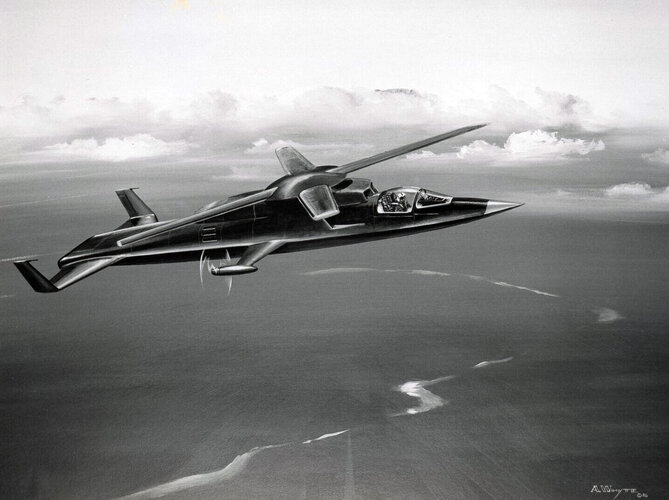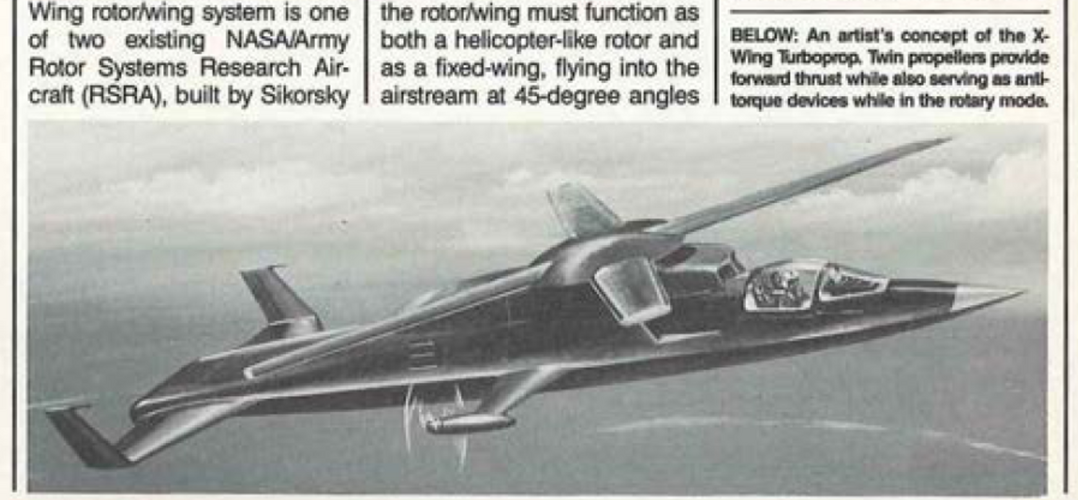You are using an out of date browser. It may not display this or other websites correctly.
You should upgrade or use an alternative browser.
You should upgrade or use an alternative browser.
Sikorsky X-Wing Projects
- Thread starter overscan (PaulMM)
- Start date
Scott Kenny
ACCESS: USAP
- Joined
- 15 May 2023
- Messages
- 11,279
- Reaction score
- 13,729
That particular airframe design was fatally flawed. Both crashed due to an uncontrollable pitch movement, and the second one was supposed to have fixed that.Thank you for the answer, did not know about the second crash.whatever happened?
Both vehicles crashed, dramatically.
however, unsatisfying it is not to know why the technology was not furthered. Such a radical technology/capability is going to have many hiccups but the payoff may have been worth it.
Scott Kenny
ACCESS: USAP
- Joined
- 15 May 2023
- Messages
- 11,279
- Reaction score
- 13,729
How so? It was my understanding that the X-wing rotor just used compressor bleed air, not the exhaust stream. I'm not convinced that compressor bleed air would be any hotter than the friction of the blades through the air.LHX was never proposed for the LHX competition. There were artists' concepts of how an LHX sized X-Wing would look, but Sikorsky realized that since no one knew how to build one, the Army wasn't going to award the program to such a vehicle. It didn't help that the actual X-Wing rotor would also function as a homing beacon for IR missiles. Plus, once the LHX specifications were rewritten to exclude Tilt-Rotor, those exclusions would go quadruple for an X-Wing even if you could build one.
- Joined
- 6 August 2007
- Messages
- 3,859
- Reaction score
- 5,800
From Aviation Week, Feb. 6 1996:
From Sharon Weinberger. “The Imagineers of War.” :
DARPA SOUGHT STEALTHY ROTORCRAFT
02/06/96
The former Defense Advanced Research Projects Agency funded at least two secret rotorcraft programs during the 1980s, and at least one of them is still operating. They were low radar cross section technology demonstrators and did not have an operational mission.
The larger of the two was a secret version of the NASA/DARPA/Sikorsky X-Wing Rotor Systems Research Aircraft (RSRA), and it is not clear if a prototype ever flew. The unclassified RSRA X-Wing program was canceled in 1988 after several flights in only its fixed-wing mode (AW&ST Mar. 14, 1988, p. 15; Aug. 31, 1987, p. 23). However, DARPA's secret version of the X-Wing also run by Sikorsky-was a larger program than its unclassified cousin, according to sources familiar with both programs.
THE SMALL ROTORCRAFT is a McDonnell Douglas Helicopters project conducted with the renamed Advanced Research Projects Agency. Configuration details are sketchy, and it is not known if it uses the McDonnell Douglas no-tail-rotor (Notar) technology. More than one of the McDonnell Douglas craft may have been built, and flights are conducted in the restricted airspace of the Nellis AFB range. Tests include flying against radar sites to measure the rotorcraft's signature. The program is considered "extremely black," and the aircraft fly at night or out of sight of uncleared personnel during the day. Flights are scheduled to avoid spy satellite coverage.
It is not clear whether Bell participated in a DARPA stealth helicopter project. One expert noted that the teetering two-bladed rotor used on many Bell helicopters does not adapt itself to stealth. The clearance needed for teetering makes it difficult to closely nest the hub to a fuselage fairing, and the high blade loading is noisier and gives a larger, more visible, rotor diameter. However, Bell has developed helicopters aimed at the special operations market.
The secret X-wing was to use three enabling technologies for low radar signature. One was the X-wing itself. When the rotor was stopped for cruise flight in the "X" position, the 45-deg. angle of the blades reduced radar reflections in the forward aspect, though care had to be taken to prevent the 90-deg. blade intersection from acting as a retroreflector. Also, the stopped blades eliminated the telltale Doppler signature of a helicopter. Equally important, the fixed X-wing allowed for high speed, as retreating blade stall and high tip Mach numbers were eliminated. High speed was the goal of the "white-world" RSRA X-Wing program. Notar-like technology was the second key feature of the stealth X-wing. Eliminating the tail rotor reduces radar signature. However, the Sikorsky design did not use circulation control blowing on the boom itself for anti-torque boom lift, as McDonnell Douglas does with its Notar technology. Instead the stealth X-wing just had thrusters at the tail boom's tip. The RSRA X-wing had a conventional tail rotor.
THE THIRD TECHNOLOGY was an engine that could convert between turboshaft mode for helicopter operation and turbofan for cruise thrust. The convertible engine was a General Electric TF34 turbofan that was tested by the NASA Lewis Research Center (AW&ST Oct. 27, 1986, p. 21). For turboshaft operation, the fan's inlet and exit guide vanes were shut, closing air to the engine's bypass duct and increasing airflow directed through core. The secret aircraft was to use twin convertible TF34s, while the RSRA X-wing used two standard TF34s for thrust and two General Electric T58s for shaft power. The RSRA X-wing program provided an open method to develop the crucial X-wing technology, and provided cover for the broad nature of the classified effort. The white program could order parts for the black program, and vendors would be none the wiser.
From Sharon Weinberger. “The Imagineers of War.” :
As DARPA’s black aircraft programs boomed in the 1980s, the agency would often announce a research program in aeronautics as a cover for building a secret military prototype aircraft. This enabled DARPA to award contracts and buy needed equipment without raising suspicion. Atkins described one example of what he called a “White World” program, meaning unclassified, that was run jointly with NASA. Yet the technology was also being looked at for secret military applications. “We built some full-scale models to see how we would militarize it,” said Atkins. The “black” project was a stealth rotorcraft.
The cover project was called the Rotor Systems Research Aircraft/ X-Wing, or RSRA, a “joint DARPA-NASA program that funded Sikorsky to design a hybrid of a helicopter and a fixed-wing aircraft. RSRA was a real program, but it was also a cover for one of DARPA’s more significant attempts to develop stealth helicopters. The “black” program involved taking “the rotor head off of the RSRA and putting it onto a stealth vehicle,” Atkins said. A helicopter’s rotor blades typically produce a Doppler shift. Those shifts are difficult to mask from radar, but it could be done, as DARPA learned with the X-Wing.
You should see the full-color version in APR issue V5N6:This picture appeared earlier in this thread but this is a better copy.
https://www.aerospaceprojectsreview.com/pv5n6.htm

https://www.aerospaceprojectsreview.com/pv5n6.htm
- Joined
- 25 July 2007
- Messages
- 4,297
- Reaction score
- 4,182
From Army Aviation 1986/10.
Source: Army Aviation, Volume 35, Number 10, 31 October 1986, Sikorsky's X-Wing: A Trip into the Future, by Dr. Kenneth M. Rosen, Director Advanced V/STOL Programs, Sikorsky Aircraft, pp 18-19.
Similar threads
-
-
-
-
Sikorsky S-61 prototypes, projects and license builds
- Started by Caravellarella
- Replies: 61
-



